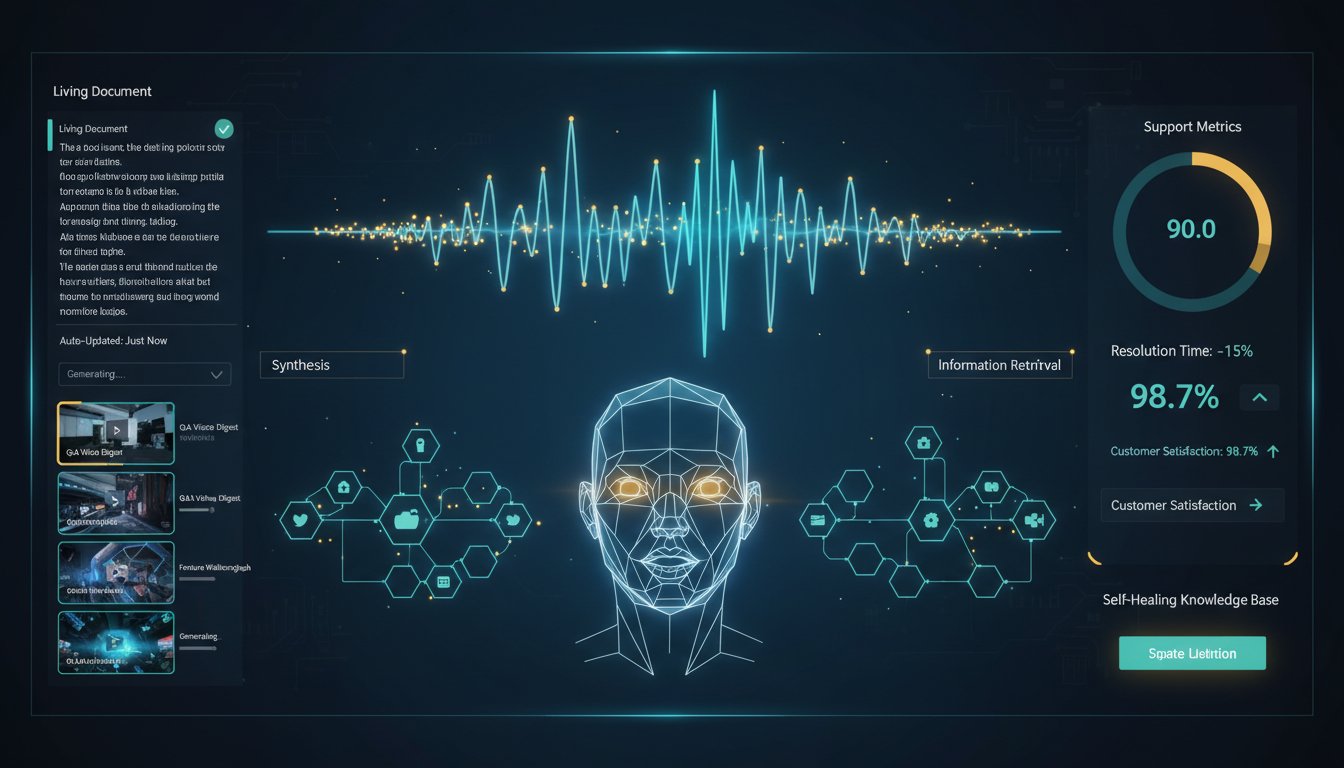Picture this: Your enterprise AI system receives a complex query about “quarterly revenue trends for sustainable packaging products in the European market, including regulatory compliance requirements and competitor analysis.” A traditional RAG system would struggle to coordinate the multiple data sources, analytical steps, and specialized knowledge domains required. But what if your RAG system could automatically deploy specialized AI agents—each an expert in finance, sustainability, regulations, and competitive intelligence—working together like a perfectly orchestrated team?
This is the reality of multi-agent RAG orchestration, where autonomous AI agents collaborate to handle complex enterprise queries that single-agent systems simply cannot manage effectively. As organizations deal with increasingly sophisticated information needs spanning multiple domains, departments, and data sources, the limitations of traditional RAG approaches become painfully apparent.
In this comprehensive guide, we’ll explore how to architect and implement multi-agent RAG orchestration systems that can handle the most complex enterprise scenarios. You’ll learn the theoretical foundations, practical implementation strategies, and real-world deployment considerations that separate successful multi-agent RAG systems from expensive failed experiments. By the end, you’ll have a complete framework for building orchestration systems that can coordinate multiple specialized agents to deliver insights no single AI could provide.
Understanding Multi-Agent RAG Orchestration Architecture
Multi-agent RAG orchestration represents a fundamental shift from monolithic AI systems to distributed intelligence networks. Unlike traditional RAG systems that rely on a single retrieval-generation pipeline, orchestration systems deploy multiple specialized agents, each optimized for specific tasks, data types, or knowledge domains.
The core architecture consists of three primary layers: the orchestration layer, the agent layer, and the coordination layer. The orchestration layer serves as the central command center, receiving queries, decomposing them into subtasks, and routing these tasks to appropriate specialized agents. This layer implements sophisticated query planning algorithms that can analyze incoming requests and determine the optimal agent deployment strategy.
The agent layer contains the specialized AI agents themselves, each designed for specific functions like document retrieval, data analysis, knowledge synthesis, or domain-specific reasoning. These agents operate independently but communicate through standardized protocols, allowing them to share information and coordinate their efforts seamlessly.
The coordination layer manages the complex interactions between agents, handling everything from task scheduling and resource allocation to conflict resolution and result synthesis. This layer ensures that multiple agents can work simultaneously without stepping on each other’s operations while maintaining data consistency and avoiding redundant processing.
Agent Specialization Strategies
Successful multi-agent RAG systems rely on careful agent specialization. Rather than creating generalist agents that attempt to handle everything, effective systems deploy agents optimized for specific functions or knowledge domains.
Data source specialists focus on particular types of information repositories. For example, a structured data agent might excel at querying SQL databases and interpreting tabular data, while an unstructured document agent specializes in processing PDFs, research papers, and text documents. A web intelligence agent could focus on real-time information gathering from online sources, APIs, and news feeds.
Domain knowledge specialists bring deep expertise in specific business areas. A financial analysis agent understands accounting principles, regulatory requirements, and market dynamics. A legal research agent knows how to navigate complex regulatory frameworks and interpret compliance requirements. A technical documentation agent excels at processing engineering specifications and technical manuals.
Process specialists handle specific analytical functions regardless of domain. A summarization agent excels at distilling large amounts of information into concise insights. A comparison agent specializes in identifying similarities, differences, and trends across multiple data points. A validation agent focuses on fact-checking and ensuring information accuracy.
Implementing Agent Communication Protocols
Effective multi-agent RAG systems require sophisticated communication protocols that enable seamless information sharing while maintaining system reliability and performance. The foundation of these protocols lies in standardized message formats that all agents can understand and process.
Implement asynchronous message passing using event-driven architectures. Each agent publishes events when completing tasks or discovering relevant information, allowing other agents to react and adapt their strategies accordingly. This approach prevents bottlenecks that would occur if agents had to wait for each other to complete tasks sequentially.
Establish clear data contracts between agents, specifying the format, structure, and semantics of information exchanges. These contracts ensure that when one agent shares retrieved documents, analytical results, or contextual insights, receiving agents can immediately understand and utilize the information without additional processing overhead.
Create intelligent routing mechanisms that can dynamically determine which agents should receive specific information based on their capabilities and current tasks. Rather than broadcasting all information to all agents, smart routing reduces network overhead and cognitive load while ensuring relevant information reaches the right specialists.
Coordination Algorithms and Strategies
The orchestration system must implement sophisticated algorithms for coordinating agent activities and synthesizing their outputs into coherent responses. Task decomposition algorithms analyze incoming queries to identify independent subtasks that can be processed in parallel, as well as dependent tasks that must be completed sequentially.
Implement consensus mechanisms for handling conflicting information from different agents. When multiple agents provide different answers to the same question or retrieve contradictory data, the orchestration system must have strategies for resolution. This might involve confidence scoring, source credibility weighting, or additional verification steps.
Develop resource management algorithms that optimize agent deployment based on current system load, agent availability, and task complexity. The system should be able to scale agent instances up or down based on demand while maintaining response quality and managing computational costs.
Create result synthesis pipelines that can intelligently combine outputs from multiple agents into comprehensive responses. This goes beyond simple concatenation to include intelligent merging, conflict resolution, and coherence checking to ensure the final response maintains logical consistency and addresses all aspects of the original query.
Building Scalable Orchestration Infrastructure
Scalability represents one of the most critical challenges in multi-agent RAG orchestration. As your system handles more complex queries and deploys additional specialized agents, the infrastructure must scale gracefully without degrading performance or reliability.
Implement containerized agent deployment using technologies like Docker and Kubernetes. This approach allows you to scale individual agent types independently based on demand patterns. If your system frequently receives financial analysis requests, you can scale up financial agents while maintaining standard levels of other agent types.
Design stateless agent architectures wherever possible, enabling horizontal scaling without complex state synchronization challenges. Stateless agents can be quickly instantiated, destroyed, and relocated across your infrastructure without impacting system performance or losing critical information.
Establish comprehensive monitoring and observability systems that track agent performance, communication patterns, and resource utilization. These systems should provide real-time insights into bottlenecks, failure patterns, and optimization opportunities across your multi-agent ecosystem.
Performance Optimization Techniques
Optimize agent deployment strategies based on query patterns and historical performance data. Implement predictive scaling that can anticipate demand spikes and pre-position agents accordingly. If your system typically receives a surge of market analysis requests at market opening, the orchestration system should proactively scale relevant agents before the surge begins.
Implement intelligent caching strategies at multiple levels within the orchestration system. Cache frequently accessed documents, common analytical results, and even partial query responses that can be reused across similar requests. This reduces redundant processing and improves response times significantly.
Develop load balancing algorithms that consider not just agent availability but also agent specialization and current context. The system should route tasks to agents that are not only available but also optimally positioned to handle specific requests based on their recent activity and cached knowledge.
Create circuit breaker patterns that protect the overall system when individual agents fail or become unresponsive. Rather than allowing cascading failures, circuit breakers can isolate problematic agents while maintaining system functionality through alternative routing strategies.
Advanced Query Planning and Execution
Sophisticated query planning distinguishes exceptional multi-agent RAG systems from basic implementations. Advanced planning algorithms can analyze complex queries to identify optimal execution strategies that minimize latency while maximizing result quality.
Implement dependency graph analysis that can identify which subtasks must be completed before others can begin, as well as which subtasks can be executed in parallel. This analysis enables the orchestration system to create optimal execution plans that minimize total processing time while respecting logical dependencies.
Develop adaptive planning algorithms that can modify execution strategies based on intermediate results. If an initial agent discovers that certain information is unavailable or that the query requires additional analysis, the planning system should be able to dynamically adjust the execution plan without starting over.
Create cost-aware planning that considers computational resources, response time requirements, and result quality targets. Different execution strategies may offer trade-offs between speed and thoroughness, and the planning system should be able to optimize based on specific requirements for each query.
Dynamic Agent Allocation Strategies
Implement sophisticated agent allocation algorithms that go beyond simple round-robin or random assignment. Consider agent specialization, current workload, recent performance history, and available cached knowledge when making allocation decisions.
Develop workload prediction models that can anticipate resource needs based on query complexity and historical patterns. These models enable proactive agent scaling and resource allocation, reducing response times and improving user experience.
Create agent affinity mechanisms that keep related tasks assigned to the same agents when beneficial. If an agent has already loaded specific documents or built relevant context for a particular domain, routing related queries to the same agent can improve efficiency and result quality.
Establish failover and recovery protocols that can seamlessly handle agent failures without impacting query processing. The orchestration system should be able to detect agent failures quickly and redistribute tasks to healthy agents while maintaining processing continuity.
Quality Assurance and Result Validation
Multi-agent RAG systems introduce additional complexity in ensuring result quality and accuracy. With multiple agents contributing to final responses, implementing comprehensive quality assurance becomes both more challenging and more critical.
Implement multi-layer validation strategies that check results at the agent level, coordination level, and final synthesis level. Agent-level validation ensures individual agents produce high-quality outputs within their specialization areas. Coordination-level validation checks for consistency and logical coherence between agent outputs. Synthesis-level validation ensures the final combined response addresses the original query comprehensively and accurately.
Develop confidence scoring mechanisms that aggregate confidence levels from individual agents while accounting for potential correlations and dependencies. The orchestration system should be able to provide overall confidence scores that accurately reflect the reliability of synthesized responses.
Create automated fact-checking pipelines that can verify key claims and data points across multiple agents and sources. These pipelines should be able to identify potential inconsistencies, outdated information, or conflicting sources that require human review or additional verification.
Monitoring and Observability
Establish comprehensive logging systems that track the complete lifecycle of queries through the multi-agent system. This includes query decomposition decisions, agent allocation strategies, communication patterns, processing times, and result synthesis steps. Detailed logging enables troubleshooting, performance optimization, and system improvement over time.
Implement real-time performance monitoring that tracks key metrics across all system components. Monitor agent response times, resource utilization, error rates, and result quality scores. Create alerting systems that can notify administrators of performance degradations or system anomalies before they impact user experience.
Develop analytics dashboards that provide insights into system usage patterns, agent effectiveness, and optimization opportunities. These dashboards should help identify which agents are most valuable for different query types, where bottlenecks commonly occur, and how system performance evolves over time.
Create audit trails that maintain detailed records of how specific responses were generated, which agents contributed, and what sources were consulted. These audit trails are essential for maintaining accountability, supporting compliance requirements, and enabling continuous system improvement.
Building successful multi-agent RAG orchestration systems requires careful attention to architecture, implementation details, and operational considerations. The complexity of coordinating multiple AI agents while maintaining performance and reliability presents significant challenges, but the potential for handling sophisticated enterprise queries that single-agent systems cannot address makes this investment worthwhile. As organizations continue to push the boundaries of what’s possible with enterprise AI, multi-agent orchestration represents the next frontier in RAG system capabilities.
The frameworks and strategies outlined in this guide provide a solid foundation for implementing production-ready multi-agent RAG systems. However, successful deployment requires careful planning, iterative refinement, and ongoing optimization based on real-world usage patterns and performance data. Start with clear use cases, implement robust monitoring from day one, and be prepared to evolve your orchestration strategies as you learn more about your specific requirements and constraints. Ready to transform how your organization handles complex information queries? Begin by identifying your most challenging multi-domain use cases and designing specialized agents that can work together to deliver insights no single AI could provide alone.




